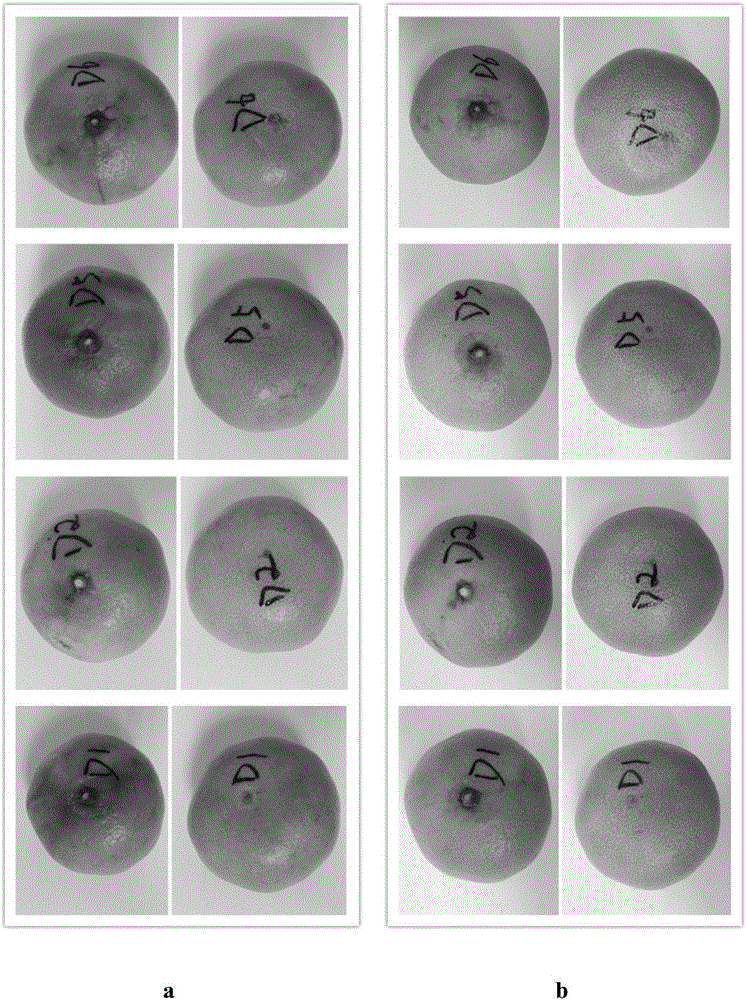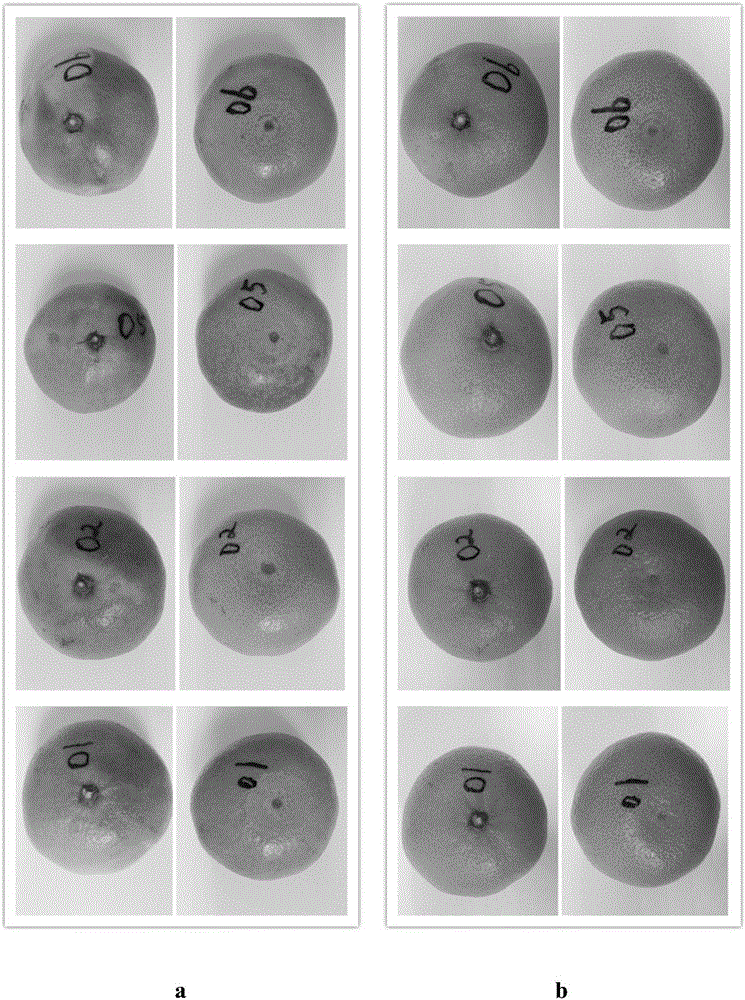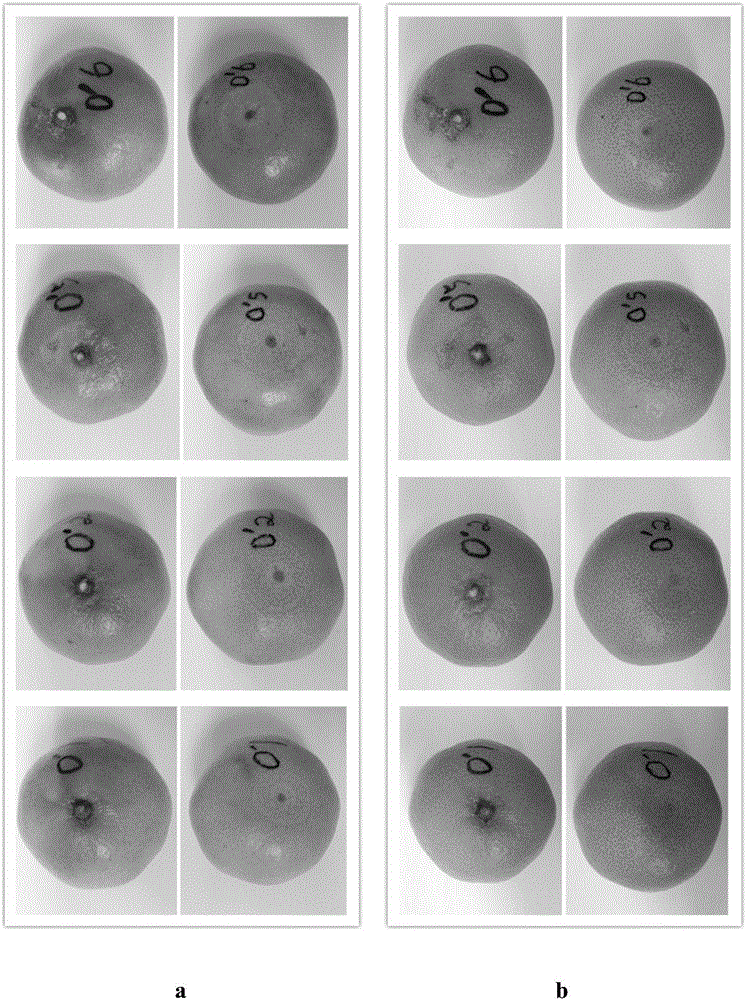Application of 2-(4-methoxyphenoxy) propionic acid and antiseptic preservative agent for preservation of citrus after harvest
The technology of methoxyphenoxy and antistaling agent is applied in the field of antistaling agent, and achieves the effects of high efficiency antiseptic and antistaling, simple and easy processing method, and excellent anticorrosion and antistaling effect.
- Summary
- Abstract
- Description
- Claims
- Application Information
AI Technical Summary
Problems solved by technology
Method used
Image
Examples
Embodiment 1
[0049] 1) Solution preparation: Weigh 2.0g and 0.2g of MPP sodium salt solid powder into 5L tap water respectively to prepare 400ppmMPP and 40ppmMPP sodium salt solution; weigh 1.8g of 2,4-D solid powder, dissolve in water and use NaOH solution Adjust the pH to neutral, dilute to 5L with tap water, and prepare a 400ppm 2,4-D solution.
[0050] 2) Experimental treatment: select Wenzhou satsuma, soak the citrus fruits in the above three solutions and tap water for 3 minutes, dry them naturally, bag the fruits, store them at room temperature, and check the antiseptic and freshness of citrus regularly.
[0051] 3) Experimental results, the obtained experimental results are shown in Table 1.
[0052] Table 1 The experimental results of MPP sodium salt on postharvest storage of Wenzhou mandarin citrus fruits
[0053]
[0054] The experimental results showed that the antiseptic and fresh-keeping effect of the MPP sodium salt group and the 2,4-D group was better than that of the t...
Embodiment 2
[0056] 1) Solution preparation: Weigh 0.5g MPP sodium salt solid powder into 5L tap water to prepare 100ppm MPP sodium salt solution; weigh 5g chitosan and 0.5g MPP sodium salt solid powder into 5L tap water to prepare 100ppm MPP sodium salt Mix solution with 0.1% chitosan; weigh 0.45g 2,4-D solid powder, dissolve in water, adjust pH to neutral with NaOH solution, dilute to 5L with tap water, and prepare 100ppm 2,4-D solution.
[0057] 2) Experimental treatment: choose Shatangju, soak the citrus fruits in the above three solutions and tap water for 3 minutes, dry them naturally, bag the fruits, store them at room temperature, and check the antiseptic and freshness of citrus regularly.
[0058] 3) Experimental results, the obtained experimental results are shown in Table 2.
[0059] Table 2 The experimental results of MPP sodium salt on postharvest storage of sugar mandarin fruit
[0060]
[0061] The experimental results showed that the preservation effect of MPP sodium sa...
Embodiment 3
[0063] 1) Solution preparation: Weigh 0.5g MPP sodium salt solid powder into 5L tap water to prepare 100ppm MPP sodium salt solution; weigh 5g chitosan and 0.5g MPP sodium salt solid powder into 5L tap water to prepare 100ppm MPP sodium salt +0.1% chitosan mixed solution; weigh 0.45g 2,4-D solid powder, dissolve in water, adjust pH to neutral with NaOH solution, dilute to 5L with tap water, and prepare 100ppm 2,4-D solution.
[0064] 2) Experimental treatment: choose emperor mandarin oranges, soak the citrus fruits in the above three solutions and tap water for 3 minutes, dry them naturally, bag the fruits, store them at room temperature, and check the antiseptic and freshness of citrus regularly.
[0065] 3) Experimental results, the obtained experimental results are shown in Table 3.
[0066] Table 3 MPP sodium salt on the postharvest storage antiseptic preservation experiment results of emperor tangerine
[0067]
[0068] The experimental results showed that the preserv...
PUM
 Login to View More
Login to View More Abstract
Description
Claims
Application Information
 Login to View More
Login to View More - R&D
- Intellectual Property
- Life Sciences
- Materials
- Tech Scout
- Unparalleled Data Quality
- Higher Quality Content
- 60% Fewer Hallucinations
Browse by: Latest US Patents, China's latest patents, Technical Efficacy Thesaurus, Application Domain, Technology Topic, Popular Technical Reports.
© 2025 PatSnap. All rights reserved.Legal|Privacy policy|Modern Slavery Act Transparency Statement|Sitemap|About US| Contact US: help@patsnap.com



